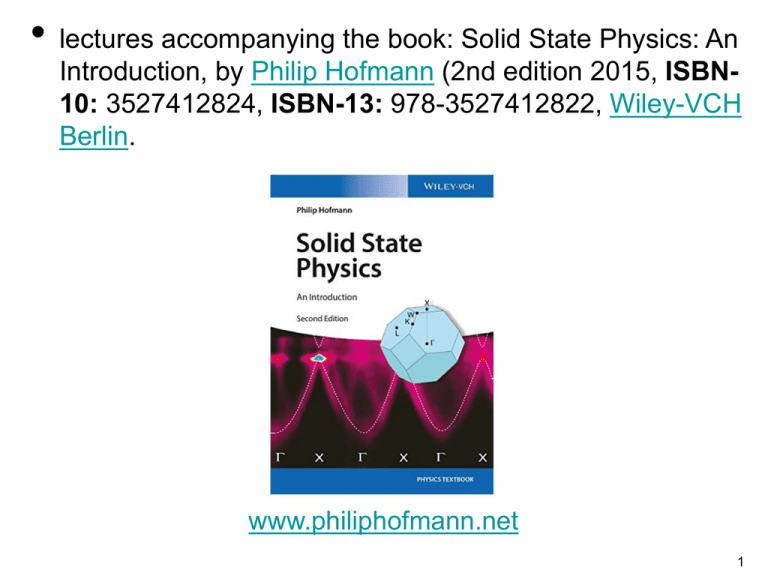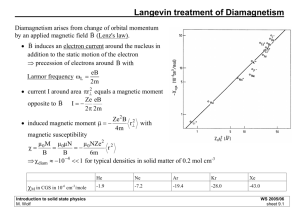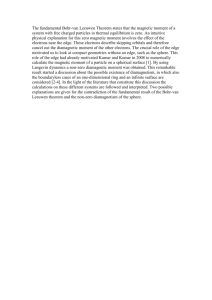powerpoint - Philip Hofmann
advertisement

• lectures accompanying the book: Solid State Physics: An Introduction, by Philip Hofmann (2nd edition 2015, ISBN10: 3527412824, ISBN-13: 978-3527412822, Wiley-VCH Berlin. www.philiphofmann.net 1 Magnetism • • 2 How do solids react to an external field? What is the cause of spontaneous magnetic ordering? Magnetic properties at the end of this lecture you should understand.... • • • • 3 Macroscopic description of magnetism Magnetic moments in atoms Weak magnetism in solids Magnetic ordering Macroscopic description of magnetism magnetic induction in vacuum magnetic field in general we have Gauss’ law for magnetostatics 4 Macroscopic description of magnetism magnetic induction in vacuum in matter we interpret magnetic susceptibility magnetic field magnetization as the “external field” magnetic dipole moment potential energy of one dipole in the external field: 5 Units • • 6 Both, and are measured in Tesla (T) 1 T is a strong field. The magnetic field of the earth is only in the order of 10-5 T. object in homogeneous magnetic field potential energy of one dipole in the external field: so for a macroscopic object that is magnetized by the field Note quite because now M depends on the field so 7 Diamagnetism • • 8 Diamagnetism: negative susceptibility, the magnetization opposes the external field, the potential energy is lowered when moving the magnetized bodies to a lower field strength. A diamagnet opposes both poles of a magnet. Diamagnetism is caused by “currents” induced by the external field. According to Lenz’ law, these currents always lead to a field opposing the external field. Paramagnetism • • 9 Paramagnetism: positive susceptibility, the magnetization is parallel to the external field, the potential energy is lowered when moving the magnetized bodies to a higher field strength. A paramagnet is attracted to either pole of an external magnet. Paramagnetism is caused by aligning some dipoles, which are already present, with the magnetic field. for fixed external field but if the field is turned on from zero 10 • 11 Classical physics does not give diamagnetism or paramagnetism! The vector potential scalar potential for static electric field scalar potential for B-field? No! One can choose 12 The vector potential particle in electromagnetic field change the momentum (operator) change the potential 13 Quantum Mechanical Description constant B field (in z-direction) chosen such that 14 Quantum Mechanical Description because use that B only in z direction 15 paramagnetic term diamagnetic term Quantum Mechanical Description use that B only in z direction paramagnetic term diamagnetic term Spin is not contained in Schrödinger equation but could be added as 16 Quantum Mechanical Description magnetic moment very rough estimate for an atom with Z electrons 17 Proper situation in atoms • • 18 Which magnetic moments are already there? They will lead to paramagnetism. Does an external field induce a magnetic moment? This will lead to diamagnetism. Magnetic moments in atoms orbital angular momentum magnetic moment component in field direction magnetic moment due to electron spin component in field direction 19 gyromagnetic ratio Magnetic moments in atoms for many electron atoms and a given sub-shell (n,l) so no magnetic moment for closed shells Non-closed shells have the total angular momentum and 2J+1 possibilities of a magnetic moment in field direction Landé splitting factor 20 (1) find J (2) find the Landé splitting factor g Magnetic moments in atoms for many electron atoms and a given sub-shell (n,l) for non-closed shells follow Hund’s rules (1) The electrons should occupy the orbitals such that the maximum possible value of the total spin S is realized. 21 Example: Mn2+ • • 22 example Mn2+ with 5 d electrons, all in different ml orbitals (no overlap, smallest repulsion) The total spin S has a major influence on the total energy. Magnetic moments in atoms for many electron atoms and a given sub-shell (n,l) for non-closed shells follow Hund’s rules (2) The electrons should occupy the orbitals such that the maximum of L consistent with S is realized. 23 Magnetic moments in atoms for many electron atoms and a given sub-shell (n,l) for non-closed shells follow Hund’s rules (3) The total angular momentum J is calculated • • • 24 If the sub-shell is less than half-full J=L-S If the sub-shell is more than half full J=L+S If the sub-shell is half full, L=0 and J=S Example: Cr3+ • • • • 25 Cr3+ has three electrons in the 3d sub-shell. The first of Hund’s rules requires S=3/2. The possible ml values for the 3d shell are -2,-1,0,1,2. Hund’s second rule requires to choose the largest possible value of L, i.e. to choose ml =0,1,2, so L=3. Since the sub-band is less than half filled, J=L-S=3-3/2=3/2. Magnetic moments in atoms the moment in field direction is with mj = -J,-J+1,...J-1,J and the Landé splitting factor the highest possible moment in field direction is 26 Summary atomic magnetism • • • 27 Non-filled shells can lead to a permanent magnetic moment described by the total angular momentum J and the Landé factor. This magnetic moment gives rise to paramagnetism. An external field also gives rise to a diamagnetic response by “inducing a current” in all atomic shells. This gives rise to diamagnetic moment which is always present. We have an estimate for the size of both types of magnetic moments. Weak magnetism in solids • • • • 28 Atomic diamagnetic contribution is always there. The paramagnetic behaviour of non-filled shells is often not present in solid (example: ionic solids) The paramagnet behaviour of non-filled shells can be retained if these are inner shells (f- electrons). Additional contribution are expected to arise from itinerant electrons in metals. Diamagnetism from the atoms And this is always quite small, 10-5 or so. 29 (Landau) diamagnetism of free electrons 30 Curie paramagnetism • Treat the localized d and f • • • electrons as if they were atomic magnets. This leads to a paramagnetic solid. The paramagnetism is caused by the alignment of existing dipoles to the external field. The system consists of distinguishable dipoles with known energy levels. Boltzmann statistics can be applied and the effect is temperature-dependent. 31 Curie paramagnetism energy levels partition function mean moment in field direction 32 Curie paramagnetism: limiting cases 1. all moments aligned with field (independent of field strength) 2. so that Curie’s law 33 Curie paramagnetism: limiting cases • • The highest possible magnetization is big. But for room temperature, we are in the other regime: the susceptibility is quite small (10-3 - 10-2 or so). Curie’s law 34 Curie paramagnetism: limitations • • • 35 The Curie constant C is predicted correctly for the f transition metals (exercise). For the d transition metals, the agreement is poor. One often observes a C as if J=S (quenching of orbital angular momentum) The reason is that the d electrons act as valence electrons / interact strongly with the neighbours and can not be treated like purely atomic levels. Pauli paramagnetism • • • 36 Pauli paramagnetism is associated with the spin of the free electrons. Naively, one might expect that all the electrons align their magnetic moment with the external field. This would give rise to strong paramagnetism. This is not observed, a puzzling fact for a long time (along with the electrons’ heat capacity). You can guess where this is leading.... Pauli paramagnetism (twice) the coloured area: 38 which is again quite small Aligning all the moments paramagnetism of localized ions 39 Pauli paramagnetism Magnetic response of solids (without Curie pm) • • All solids show very weak diamagnetism, like the atoms. Free electron metals show the weak Pauli paramagnetism and Landau diamagnetism. • The resulting χ is in the order of 10 -6 to 10-5. a ‘qualitative equation’ for the total susceptibility is diamagnetic part paramagnetic part of conduction of conduction electrons electrons 40 diamagnetic part of atoms 41 More fun with diamagnetic levitation movies 42 source: High Field Magnet Laboratory, University of Nijmegen Magnetic ordering • • 43 So far: magnetic response of the solid as a function of applied field (diamagnetic / paramagnetic). Quite weak for most solids at room temperature. Now: spontaneous magnetic ordering without any applied field. Magnetic ordering 44 Magnetic ordering: a common misconception • 45 The magnetic ordering IS NOT caused by the direct magnetic interaction between magnetic moments. This is much too weak (exercise). Example: Mn2+ • • • 46 Origin: Coulomb repulsion and Pauli exclusion principle example Mn2+ with 5 d electrons, all in different ml orbitals (no overlap, smallest repulsion) The total spin S has a major influence on the total energy. The Hydrogen Molecule: basic “ordering” and the exchange interaction solution solution 47 The Hydrogen Molecule 48 ground state solution ground state solution close but no interaction 49 Identical Particles probability for finding electron of atom A at r1 and electron of atom B at r2 probability for finding electron of atom B at r1 and electron of atom A at r2 but these are not the same! 50 Identical Particles probability for finding electron of atom A at r1 and electron of atom B at r2 probability for finding electron of atom B at r1 and electron of atom A at r2 but these are not the same! 51 Identical Particles probability for finding electron of atom A at r1 and electron of atom B at r2 probability for finding electron of atom B at r1 and electron of atom A at r2 but these are not the same! 52 Identical Particles but we must have so that and we have to get the same upon another exchange 53 Identical Particles two possible solutions symmetric (u=1) anti-symmetric (u=-1) 54 Identical Particles Empirical rules for two Fermions The total wave function for Fermions (including spin) must be anti-symmetric upon particle exchange The symmetric solution is chosen when the spins are anti-parallel The anti-symmetric solution is chosen when the spins are parallel 55 The Hydrogen Molecule: Heitler and London Start by using the atomic wave functions with + for spins antiparallel (singlet), S=0, ms=0 and - for spins parallel (triplet), S=1, ms=-1,0,1 56 The Hydrogen Molecule: Heitler and London as trial wave function calculate 57 The Hydrogen Molecule: Heitler and London solutions with overlap integral Coulomb integral exchange integral 58 The Hydrogen Molecule: Heitler and London with |Ψ2| |Ψ2| 59 The Hydrogen Molecule: Heitler and London anti-bonding with S(R)=0 bonding 60 The Hydrogen Molecule: Heitler and London a “magnetic view”: (+ for singlet, - for triplet) anti-bonding bonding X positive X negative 61 positive exchange? anti-symmetric • • 62 In an anti-symmetric spacial wave function, the particles are NEVER at the same place. This reduces the Coulomb repulsion. This is also true for many electrons. ...but not the whole story • • 63 We also have to consider kinetic energy. For instance, a gas of free electrons does not spontaneously magnetise. Heisenberg model Hamiltonian for two spins inspired by Heitler-London We want the energy difference between singlet and triplet state to be 2X, like in the H2 molecule. Is this the case here? = 0 or 1 (singlet, triplet) expectation values (triplet) (singlet) use (triplet) 64 (singlet) Heisenberg model Hamiltonian for two spins inspired by Heitler-London For the entire solid with external field Sum only over the (identical) nearest neighbours Mean field approximation 65 Heisenberg model Mean field approximation The magnetization is with the Weiss field 66 Heisenberg model This is like the spins in an “external field” Assume B0=0 and use the expression from the Curie magnetism for J=1/2 for the entire solid with with 67 Heisenberg model with Curie temperature 68 Temperature dependence of permanent magnets: high temperature • Above the Curie temperature the magnetic moments are still there but the solid behaves like a paramagnet according to the Curie-Weiss law. Curie temperature 69 Ferromagnetic elements and many alloys are also ferromagnetic Mostly alignment of spin magnetic moments 70 Band model of ferromagnetism 71 Ferromagnetic domains • 72 Suggested by Pierre Weiss (1907) Domain boundaries / Bloch walls • 73 Imaging domains: Bitter method, magneto-optical effects and magnetic scanning probe techniques Spin-polarized STM 74 Macroscopic ferromagnetic samples high energy in external field no external field field-induced movement of domain walls 75 Hysteresis curve saturation magnetisation remanent magnetization coercive field note that here 76




